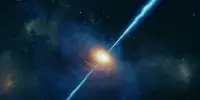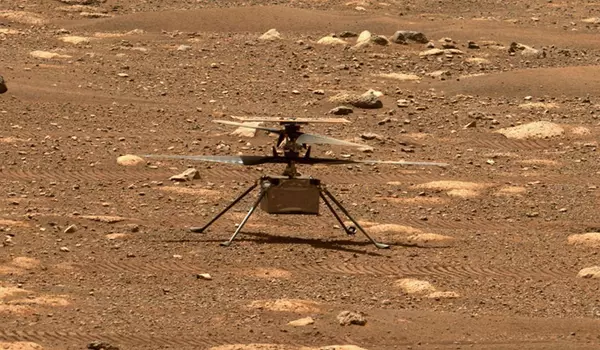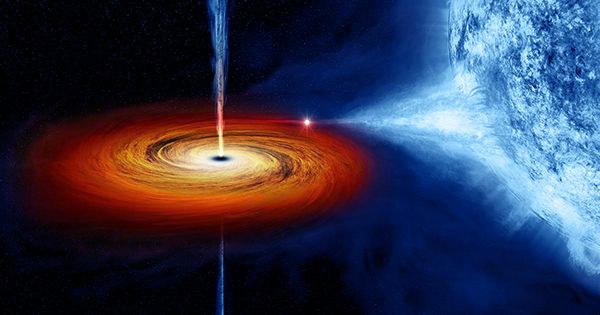A new study has discovered that the magnetic field of a star-forming cloud is strangely twisted. Researchers believe a newborn star moved into the stellar envelope of another young star to form a binary star system. The intruder changed the dynamics of the cloud, twisting its magnetic field. The new findings shed light on binary star formation and how magnetic fields influence the early stages of star formation.
From a distance, star-forming cloud L483 appears to be normal. However, as a team of astrophysicists led by Northwestern University zoomed in closer and closer, things became increasingly strange.
As the researchers peered closer into the cloud, they noticed that its magnetic field was curiously twisted. And then — as they examined a newborn star within the cloud — they spotted a hidden star, tucked behind it.
“It’s the star’s sibling, basically,” said Northwestern’s Erin Cox, who led the new study. “We think these stars formed far apart, and one moved closer to the other to form a binary. When the star traveled closer to its sibling, it shifted the dynamics of the cloud to twist its magnetic field.”
The new findings shed light on binary star formation and how magnetic fields influence the early stages of star formation. Cox will present his findings at the American Astronomical Society’s (AAS) 240th meeting in Pasadena, California. “The Twisted Magnetic Field of L483” will be presented as part of a session on “Magnetic Fields and Galaxies” on Tuesday, June 14. The study will also be published in the Astrophysical Journal next week.
These stars are still young and forming. The stellar envelope is what provides the material for the stars to form. It’s like rolling a snowball around in the snow to make it bigger and bigger. The young stars are ‘rolling’ in material in order to gain mass.
Erin Cox
Cox works as a postdoctoral fellow at Northwestern University’s Center for Interdisciplinary Exploration and Research in Astrophysics (CIERA).
Twisted mystery
Stellar nurseries are untamed and magical places. As dense clouds of gas and dust collapse to form stars, they unleash hypersonic outflows of stellar material. The magnetic field that surrounds a star-forming cloud is normally parallel to these outflows. Cox and her colleagues discovered this when they studied the large-scale L483 cloud. This typical profile was mirrored by the magnetic field.
However, when the astrophysicists used NASA’s Stratospheric Observatory for Infrared Astronomy (SOFIA) to take a closer look, things began to get strange. The magnetic field was not in fact parallel to the outflows of the newborn stars. Instead, the field was twisted 45 degrees in relation to the outflows.
“At first, it matched what theory predicts,” Cox said. “If you have a magnetized collapse, then the magnetic field is controlling how the star is forming. We expect to see this parallelism. But theory can say one thing, and observations can say another.”

Unusual binary formation
Although more observations are needed, Cox believes the twisted field is caused by a previously hidden sibling star. Using SOFIA, the astrophysics team discovered a newborn star forming inside a material envelope. Closer inspection with radio telescopes at the Atacama Large Millimeter/submillimeter Array (ALMA) in Chile revealed the second star, which shared the same stellar envelope.
“These stars are still young and forming,” Cox explained. “The stellar envelope is what provides the material for the stars to form. It’s like rolling a snowball around in the snow to make it bigger and bigger. The young stars are ‘rolling’ in material in order to gain mass.”
The two young stars form a binary system about the same distance apart as our sun and Pluto. Astrophysicists currently agree that binaries can form when star-forming clouds are large enough to produce two stars or when the disc rotating around a young star partially collapses to produce a second star. But, in the case of the twin stars in L483, Cox suspects something unusual is at work.
“There is newer work that suggests it’s possible for two stars to form far apart, and then one star to move in closer to form a binary,” Cox explained. “We think that’s what is happening here. We don’t know why one star would move toward another one, but we think the moving star shifted the dynamics of the system to twist the magnetic field.”
Cox believes that this new research will eventually provide new insights into the formation of binary stars and the planets that orbit them. The iconic scene from “Star Wars” in which Luke Skywalker wistfully gazes up at the binary stars that orbit his home planet Tatooine is well known to most people. Scientists now know that this scenario isn’t just science fiction; planets orbiting binary stars could potentially be habitable worlds.
“Learning how binary stars form is exciting because planet and star formation occur simultaneously, and binary stars interact dynamically with each other,” Cox said. “We know planets exist around these double stars from our exoplanet census, but we don’t know much about how these planets differ from those that live around isolated stars. We will be able to test these results with a statistical sample as new instruments for discovering and probing new binary systems become available.”
















